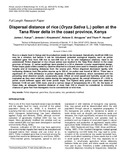| dc.contributor.author | Ireri, James Kanya | |
| dc.contributor.author | Kinyamario J.I | |
| dc.contributor.author | Amugune, O.N | |
| dc.contributor.author | Hauser P.T | |
| dc.date.accessioned | 2013-06-14T06:10:25Z | |
| dc.date.available | 2013-06-14T06:10:25Z | |
| dc.date.issued | 2009 | |
| dc.identifier.citation | KANYA, MRJAMESIRERI. 2009. Dispersal distance of rice (Oryza Sativa L.) pollen at the Tana River delta in the coast province, Kenya. Proceeding of the First Technical Conference on Meteorological research in Eastern and Southern Africa, Nairobi, Kenya. : African Meteorological Society | en |
| dc.identifier.uri | http://www.ajol.info/index.php/ajb/article/view/60565 | |
| dc.identifier.uri | http://erepository.uonbi.ac.ke:8080/xmlui/handle/123456789/33464 | |
| dc.description.abstract | Rice is a staple food in Kenya and its production needs to be increased. Genetically modified (GM) rice may be a solution, but before it can be introduced, potential ecological impacts, such as pollen mediated gene flow from GM rice to non-GM rice or to its wild indigenous relatives, need to be understood. Pollen dispersal in rice (Oryza sativa) was studied in the Tana River district in the coast province of Kenya. O. sativa seedlings were planted in a 50 m diameter circular experimental design. Pollen traps (glass slides coated by vaseline attached to a board) were used to measure pollen flow at 2 heights and at increasing distances from the source plot. Pollen dispersal decreased rapidly with
increasing distance from the pollen source up to 250 m, no pollen was found at 300 m. There was a significant (P < 0.05) difference in pollen dispersal in different directions, which correlated with the prevailing wind direction (south, occasionally east). Effect on wind speed and humidity could not be evaluated as they were relatively stable during the sampling period. No overall difference (P > 0.05) in pollen count between upper and lower pollen traps. The highest daily pollen count was observed between 11:00 am and 12:00 noon, and at a narrow range of temperatures 28 ± 2ºC. On the basis of these data, an adequate isolation distance of more than 250 m should be considered to minimize chances of gene flow from transgenic rice to conventional or wild rices. | |
| dc.language.iso | en | en |
| dc.title | Dispersal distance of rice (Oryza Sativa L.) pollen at the Tana River delta in the coast province, Kenya | en |
| dc.type | Article | en |
| local.publisher | School of Biological Sciences | en |
| local.publisher | African Journal of Biotechnology Vol. 8 (10): 2265-2270. | |

